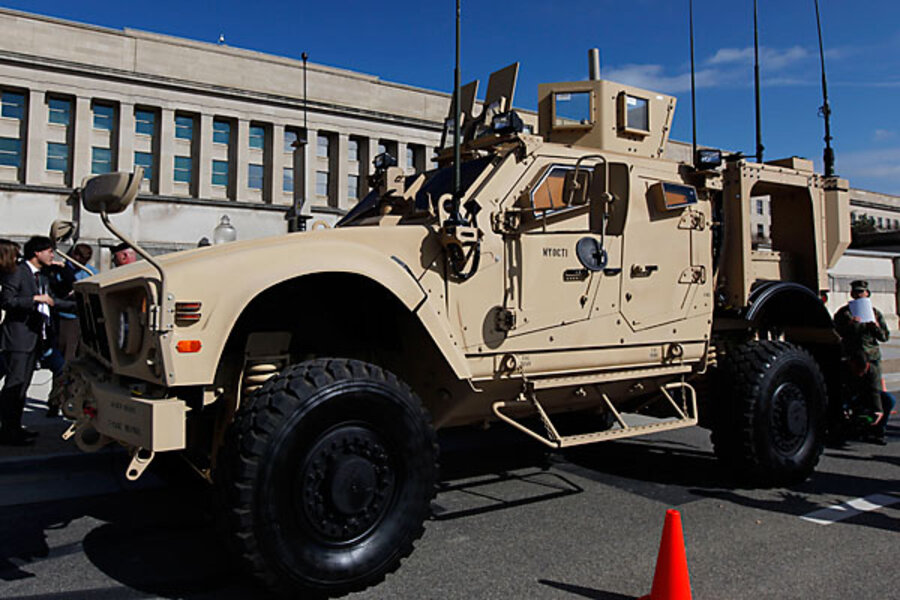Early Christmas gift: US Army off-road vehicle built for Afghanistan
Loading...
| Bagram, Afghanistan
The US military’s new all-terrain vehicle doesn’t look all that different from its lumbering predecessor. It’s painted desert sand, and reaching the cabin still means climbing a couple of steps.
On Afghanistan’s rough dirt roads, however, the new $500,000 to $1 million Mine Resistant Ambush Protected All Terrain Vehicle is a major improvement over the massive Mine Resistant Ambush Protected (MRAP) vehicle it’s replacing, soldiers say. The M-ATV is tailored to Afghanistan, at least parts of it, and the Pentagon is sending about 5,000 of them to the battlefield.
For soldiers who’d grown accustomed to bruising trips through rural Afghanistan, their first M-ATVs, which have just been introduced in the field, were an early Christmas present. Seemingly without effort, the vehicles climb mountains at angles that approach 45 degrees, and they glide across the country’s rocky roads.
In the cities, the M-ATV’s lighter frame can make sharp turns and maneuver through Afghanistan’s lawless traffic much better than the hulking MRAP can.
Introduced in 2007, the MRAP was the Army’s answer to the Iraqi insurgency’s deadliest weapon, the improvised explosive device. What worked in Iraq hasn’t worked as well in Afghanistan, however.
10,000 pounds lighter
Iraq has a network of smooth roads on flat terrain. In Afghanistan, most roads are paths of rocks and dirt, and the MRAP is ill suited for navigating its mountainous environments. The MRAP’s 36,000 pounds – more than 10,000 pounds heavier than the M-ATV – have given drivers headaches as they figure out how to maneuver around tight corners and up large hills.
Worse, McClatchy reported last month that Afghan insurgents had found vulnerabilities in the MRAP, attacking convoys with explosive charges that punched projectiles through the vehicle’s hull. IEDs have caused more than 60 percent of the coalition fatalities from hostilities in Afghanistan so far this year.
According to iCasualties.org, a Web site that tracks casualties in Iraq and Afghanistan, IEDs have killed 266 US and coalition troops so far this year, more than triple the number two years ago.
The military says the new M-ATV’s lower weight won’t mean less protection. Like the MRAP, the M-ATV’s hull is V-shaped to deflect explosions from the vehicle’s crew, but the military is withholding further details of the M-ATV’s counter-IED capabilities.
“It gives us the same protection as the MRAPs,” said Lt. Col. Michael Fordham, a reservist from outside Savannah, Ga., and the executive officer of the Georgia Army National Guard’s 48th Brigade.
One of the M-ATV’s major advantages is that unlike the MRAP, it isn’t confined to Afghanistan’s few heavy-duty roads, a limitation that helped insurgents know where to plant IEDs. However, the steep mountains of eastern Afghanistan and the orchards and deep irrigation ditches in parts of the south will limit even the 12.5-ton M-ATV’s movements.
Moreover, it’s not safe to assume that insurgents who’ve devised ways to destroy the heavier MRAP won’t in time also figure out how to disable or destroy the smaller M-ATV.
Nevertheless, the military’s efforts to counter roadside bombs undoubtedly have come a long way since 2003, when US troops invaded Iraq with paper-thin Humvees.
Chief Warrant Officer 3 Thomas Shedd, a Georgia guardsmen from Macon, in calculating the $400,000 life insurance policy the Army provides for all of its deploying soldiers, rationalized the cost of the M-ATV this way: “If four soldiers walk out of that vehicle, you just bought two” M-ATVs.
Smoother ride
For soldiers, the M-ATV offers other huge advantages over the MRAP, starting with its ride over rutted roads.
The Wisconsin-based Oshkosh Corp., which makes the M-ATVs, built in an independent suspension system, unlike the MRAP’s solid front axle, which links both wheels. If the M-ATV’s right front tire hits a rock, for example, it responds independently of the left tire. The rock might trip one wheel, but it won’t turn the entire axle one way or the other.
The M-ATV “keeps you from beating the hell out of your soldiers,” said 1st Lt. Chris Stewart of Alma, Ga. “A 12-hour drive in an MRAP beats your soldiers to death.”
The excitement among the Georgia National Guardsmen about their new vehicles, which were lined up at Bagram Air Base when the guardsmen arrived Sunday in a convoy, probably was born out of frustration with the MRAP.
The M-ATV’s dashboard is user-friendly, and radio signals come in as clearly as a telephone conversation does.
“Most of the switches in the M-ATVs are easy to reach,” said Spc. Chris Vaughn of Nashville, Ga. “The commander has access to all communications.”
“Most military vehicles are designed for someone 5’-6”, 5’-7”,” said Sgt. Rodriguez Kegler of Albany, Ga. “This is the first vehicle for someone 6 foot like me.”
(Thomas Day reports for The Telegraph in Macon, Ga.)
MORE FROM MCCLATCHY
Afghan insurgents learn to destroy key U.S. armored vehicle
In Russia, foreboding about America’s war in Afghanistan
Turmoil in Pakistan threatens Obama’s new Afghan strategy





